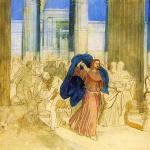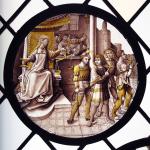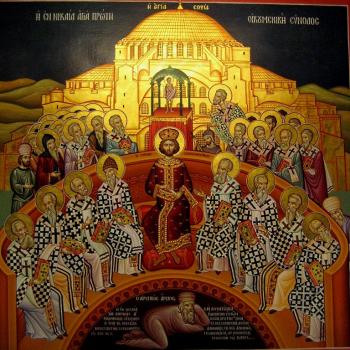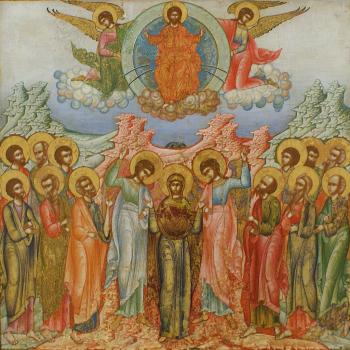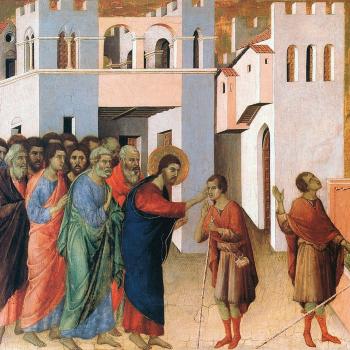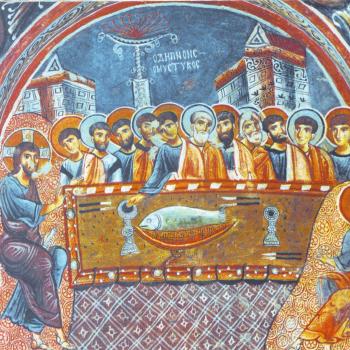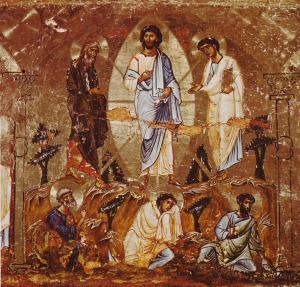
In the second letter attributed to Peter, there is a reference to the event of the Transfiguration:
For we did not follow cleverly devised myths when we made known to you the power and coming of our Lord Jesus Christ, but we were eyewitnesses of his majesty. For when he received honor and glory from God the Father and the voice was borne to him by the Majestic Glory, “This is my beloved Son, with whom I am well pleased,” we heard this voice borne from heaven, for we were with him on the holy mountain. And we have the prophetic word made more sure. You will do well to pay attention to this as to a lamp shining in a dark place, until the day dawns and the morning star rises in your hearts (2Ptr. 1:16-19 RSV).
The Transfiguration of Christ was a strange, exhilarating, and yet confusing episode of Jesus’ life. Jesus took three of the apostles up Mt. Tabor (Peter, James and John), whereupon they experienced the transcendent glory of Jesus:
And he was transfigured before them, and his face shone like the sun, and his garments became white as light. 3 And behold, there appeared to them Moses and Elijah, talking with him (Matt. 17:2-3 RSV).
When the disciples saw this, they were amazed They wanted to embrace the moment, to become attached to it. Peter wanted to make three booths, one for Jesus, one for Moses, and one for Elijah. But as Peter was speaking, “a bright cloud overshadowed them, and a voice from the cloud said, ‘This is my beloved Son, with whom I am well pleased; listen to him’” (Matt. 17:5b). The disciples fell down in awe, only to have Jesus tell them to arise without fear. When they did so, they saw that Moses and Elijah had vanished, with only Jesus remaining with them. Then, to their surprise, they were told, “Tell no one the vision, until the Son of man is raised from the dead” (Matt. 17:9b RSV).
There are many aspects to this story, each worthy of lengthy examination in their own right. Instead of focusing on one of them, a few of them will be briefly mentioned, to give a sense of what can be discerned as a result of the transfiguration.
The form which Jesus took before the apostles, where he was shining with glory, demonstrated the true glory of Jesus Christ, the glory he had for in eternity with the Father, and the glory which is his forever, even though he purposefully emptied himself of it to become man. What does it mean to say it is his when he emptied himself of it? How can he both have it and yet empty himself of it? It is the nature of true glory itself: it is something which is not held down as a possession; when we attempt to control it, we find we lose it, like a hand trying to grasp water. Only when we let the water flow across our hand will we find it in our palm. Thus, Jesus is full of glory because he empties himself of it: he does not try to grasp at it. By emptying himself of it in the incarnation, ii flows in and through him, and so it is capable of being revealed in him. It is revealed here in anticipation to the resurrection: it is the same glory, though here it is revealed only with a momentary glance, but after his death, whereby he completed his kenotic descent and entirely emptied himself of all his glory, he is completely glorified.
It is in this manner we can say he appeared to the apostles on Mt. Tabor with the glory which will be seen by all as they approach him in the eschatological judgment, as St. Jerome indicated: “He appeared to the apostles in the form in which he will appear at the time of judgment.”[1] Christ’s descent into hades and his subsequent resurrection is an eschatological event, an event all of us are called to participate in and experience, an experience which will end with our meeting with Christ in our own death. We will encounter him in his kenotic glory, as the Lord of the dead by being the one who willingly surrendered himself to death. He is raised from the dead in glory because he willingly took on death and made it his own. Because of this, Sergius Bulgakov suggested that Transfiguration was the event which shaped the end of Jesus’ earthly ministry, as it demonstrated that it was time for him to fulfill his mission, that is, it was time to embrace the cross:
The Lord’s transfiguration attests to the glory of the future age, revealed in the Parousia, the Second Coming. However, the Transfiguration is also included in the fabric of the events of the Gospel story and of the earthly ministry of the Lord Jesus. An attentive reading of the Gospel narrative convinces us that this event was a watershed in His life, analogous to the one that consisted in the appearance of Christ to the world in the Baptism. In the human aspect, the Baptism manifests Christ’s mature will to His ministry; it is an initiation, as it were, into the ministry. On the other hand, the Transfiguration manifests His mature will to the Passion, to the journey to Jerusalem for the death on the cross. At this time the Lord begins to prepare His disciples more insistently for His passion and death on the cross, for they are resistant to this salvific will because of their human infirmity. [2]
For the full glory of Jesus is revealed in the drama of the cross, and it is because of this, moreover, Jesus told the three apostles to be silent about what they had experienced. What they saw was great; indeed, if examined in detail, it can be shown to give them another sense of the truth of the Trinity (which is to be expected whenever the glory of Jesus is revealed). But by itself, without the cross, the glory would be misunderstood and abused as the apostles would try to hold on to it and think of glory as a possession (which is what they wanted to do on Mt. Tabor when they wanted to create booths).
Another important aspect of the story is that the glory, the spiritual glory, is shown to exist in Jesus with the body and not apart from it. “The transformation added splendor; it did not make his face disappear. Let it be that his body became spiritual.” [3] We are shown that our bodies are able to experience glory, to be transfigured and spiritualized. What the apostles saw revealed in the humanity of Jesus, in and through his body, will happen to all of us in our own glorification. Our body will be spiritualized. We will be like Jesus. “Beloved, we are God’s children now; it does not yet appear what we shall be, but we know that when he appears we shall be like him, for we shall see him as he is” (1Jn. 3:2 RSV). We, too, shall be glorified, and shine with glory (like Moses, who, after his encounter with God, shined so bright he had to put on a veil). The glory is revealed in the light, a light which is a visible manifestation of the radiant glory of the divine light which shines in and through all things. That glory is always there with us and all around us, but because of our poor engagement with it, because of our various inordinate attachments to its lower manifestations, we find ourselves incapable of seeing it or even being aware of it. Only when we follow Jesus’s self-kenosis and empty ourselves of all attachments will we see that glory shining through us, the glory which will be our “very being” as Paul Evdokimov taught:
The Gospel narrative of the Transfiguration reveals it is an anticipation of the Parousia and the Kingdom, but after Pentecost the light is interiorized. In rare cases it can manifest itself and be perceived by means of transfigured senses. The one who inwardly or outwardly contemplates it is transformed into light. This is because the light is not only the object but the means of the vision. Iconographically, as the nimbus of the saints show, the corporeal luminosity of the saints is ontologically normal. This is the very being of a new creature.[4]
But, as the Transfiguration is the anticipatory revelation of the kingdom of God, the presence of Moses and Elijah with Jesus also demonstrates something about the kingdom of God. It shows, what we have said, that the glory of God is meant to be experienced, and shared by us, in our body:
That Moses, and Elijah, out of the entire company of saints, were standing by, shows Christ in his Kingdom standing among the Law and the prophets, with whom he will judge Israel, in whose testimonies he was foretold. So too, the reason that Moses was visibly standing by was to teach that the glory of the resurrection was designated for human bodies. [5]
How can Moses be there? The nature of the eschatological resurrection from the dead brings the dead back to life, not just in time, but in eternity, which thus connects the resurrected person in a way with all of time. We must no longer think of the matter in a mere temporal fashion. Jesus is the lamb of God slain from the foundation of the world – and yet in a point in time and space; the eschatological kingdom is not bound by the law of time and space as it is spiritualized. The glorified forms of the saints can be encountered in a way which demonstrates the boundaries of time and space no longer affect them. Even if the resurrection of Jesus is a metaphysical prior event to the resurrection of the dead, the temporal ramifications manifests itself in a mysterious way which transcends all concept of time and space. Jesus can reveal in anticipation of the eschatological glory which he is about to accomplish this his passion, descent into hades, and the resurrection.
Likewise, by the mystery of the Transfiguration, we are shown the union between Moses, Elijah and Christ. Christians cannot, indeed, must not forget the importance of the law (represented by Moses), and the prophets (represented by Elijah). Though Christ fulfils them and brings them into glory, which is shown by their presence on Mt. Tabor, their own character and value remains, just as bodies remain a part of us after the resurrection from the dead. Those who follow through and investigate that character, even from a non-Christian standpoint, should be respected insofar as they help us understand the revelation of God given to us by Christ’s predecessors. Their fulfillment in Christ must not be used to undermine them or their relevance and value, nor their continued relevance and value for Christians today (even as they must not be held to in a way to distract us from Christ, which is why in the end, it is Jesus who remains in front of the apostles once they try to build booths to constrain what they saw).
But, most of all, in the light of glory, the apostles were taught by God. As light helps us to see, so the light of glory helps us to see spiritual truths, to see and discern what transcends our ordinary knowledge and understanding. “They were taught, in a hidden way, that the wholly blessed radiance that shone with dazzling rays of light from the Lord’s face, completely overwhelming the power of their eyes, was a symbol of His divinity, which transcends intellect, sensation, being, and knowledge.” [6] This is why, when we come to see Jesus face to face, when we see and experience him in glory, we will be truly enlightened, realizing mysteries which cannot properly by revealed through human speech. The apostles got a foretaste of this, and were told to keep silent because all that they could have said would have been misunderstood, especially before the full realization of that glory in the resurrection, but also because that glory is realized only in experience, only in the silence which transcends words.
The Transfiguration is one of the greatest events in the life of Jesus, and with it, it is one of the most theologically significant events. Christians throughout the centuries have returned to it, both through their study of Scripture, but also in their own experience of the glory of God, trying to discern what exactly is revealed to those who see and experience the glory of God for themselves. It is an event which happened once in time and yet which we can continue to approach and experience for ourselves. Let us hope, with God’s grace, we too will receive that gift, and thereby find our lives touched and transformed by the glory of God.
[1] St. Jerome, Commentary on Matthew. Trans. Thomas P. Scheck (Washington, DC: CUA Press, 2008), 198.
[2] Sergius Bulgakov, Churchly Joy. Trans. Boris Jakim (Grand Rapids, MI: William B Eerdmans Publishing Company, 2008), 139.
[3] St. Jerome, Commentary on Matthew, 198.
[4] Paul Evdokimov, Ages of the Spiritual Life. Trans. Sister Gertrude. Rev. trans. Michael Plekon and Alexis Vinogradov (Crestwood, NY: St. Vladimir’s Seminary Press, 2002), 129.
[5] St. Hilary of Poitiers, Commentary on Matthew. Trans. D. H. Williams (Washington, DC: CUA Press, 2012), 186.
[6] St. Maximos the Confessor, The Ambigua. Volume I. trans. Nicholas Constas (Cambridge: Harvard University Press, 2014), 191 [Amb. 10].
Stay in touch! Like A Little Bit of Nothing on Facebook.
If you liked what you read, please consider sharing it with your friends and family!


